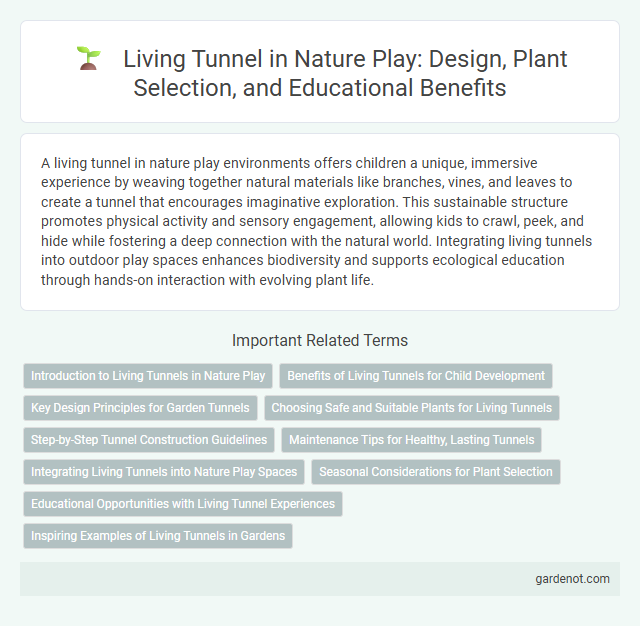A living tunnel in nature play environments offers children a unique, immersive experience by weaving together natural materials like branches, vines, and leaves to create a tunnel that encourages imaginative exploration. This sustainable structure promotes physical activity and sensory engagement, allowing kids to crawl, peek, and hide while fostering a deep connection with the natural world. Integrating living tunnels into outdoor play spaces enhances biodiversity and supports ecological education through hands-on interaction with evolving plant life.
Introduction to Living Tunnels in Nature Play
Living tunnels in nature play are natural or artificially cultivated structures formed from living plants that create immersive, interactive passageways for children. These green corridors enhance sensory experiences, encourage imaginative exploration, and foster a deeper connection with the environment. Incorporating living tunnels supports biodiversity, provides shade, and promotes physical activity through engaging, environmentally sustainable play spaces.
Benefits of Living Tunnels for Child Development
Living tunnels in nature play environments enhance sensory exploration and motor skills by encouraging children to crawl, climb, and navigate through natural materials. These structures promote imaginative play and social interaction, fostering creativity, problem-solving abilities, and teamwork. Exposure to natural elements within living tunnels also supports emotional well-being and cognitive development in early childhood.
Key Design Principles for Garden Tunnels
Living tunnels in nature play gardens emphasize organic growth patterns, using native climbing plants like wisteria or honeysuckle to create immersive green arches. Key design principles include ensuring structural safety with flexible supports, promoting biodiversity by selecting pollinator-friendly species, and maintaining accessibility for children of all abilities. Incorporating sensory elements such as varied textures and fragrant foliage enhances engagement and fosters deeper connections with the natural environment.
Choosing Safe and Suitable Plants for Living Tunnels
Selecting safe and suitable plants for living tunnels ensures structural integrity and child safety in nature play areas. Opt for non-toxic, sturdy species like willow or honeysuckle that can be easily trained and provide dense coverage without sharp thorns or allergens. Prioritize native plants adapted to local climates to reduce maintenance and promote ecological balance within the play environment.
Step-by-Step Tunnel Construction Guidelines
Creating a living tunnel involves selecting flexible, fast-growing plants such as willow or bamboo to form a strong, natural framework. Begin by planting young shoots in aligned pairs on either side of a cleared path, weaving flexible branches horizontally to shape the tunnel structure as they grow. Regular pruning and training of branches ensure dense foliage coverage and a safe, enchanting passage through the evolving natural tunnel.
Maintenance Tips for Healthy, Lasting Tunnels
Regular inspection of living tunnels ensures early detection of structural weaknesses and pest infestations, promoting longevity. Pruning surrounding vegetation prevents overcrowding while allowing sunlight penetration, essential for healthy growth. Applying organic mulch around the base retains moisture and enriches soil, fostering resilient and thriving tunnel plants.
Integrating Living Tunnels into Nature Play Spaces
Living tunnels create immersive, natural play environments by weaving living plants into functional structures that encourage exploration and imaginative play. These green, organic forms enhance sensory experiences while promoting environmental awareness and physical activity among children. Incorporating living tunnels into nature play spaces supports biodiversity, natural learning, and sustainable design principles.
Seasonal Considerations for Plant Selection
Living tunnels thrive when plant selection aligns with seasonal growth patterns, ensuring structural integrity and vibrant foliage year-round. Choosing native species with staggered bloom cycles enhances biodiversity and sustains habitat for local wildlife throughout different seasons. Incorporating deciduous vines allows sunlight penetration during winter, while dense summer growth provides natural shade and cooling benefits.
Educational Opportunities with Living Tunnel Experiences
Living tunnels offer immersive educational opportunities by engaging children in hands-on exploration of natural ecosystems and plant biology. These interactive structures foster sensory learning, encouraging curiosity about environmental processes and promoting awareness of biodiversity. Experiencing living tunnels enhances ecological literacy and inspires stewardship for the natural world through direct, meaningful interaction.
Inspiring Examples of Living Tunnels in Gardens
Living tunnels in gardens showcase innovative uses of living plants like willow, bamboo, and grapevines trained to grow into arched passages, creating immersive natural environments. Examples include the willow tunnels of the Royal Botanic Gardens in Kew, London, which blend sustainable gardening with artistic design, and the bamboo tunnels at the Shizhao Bamboo Garden in China, known for their rapid growth and graceful structure. These natural structures enhance sensory experiences, promote biodiversity, and provide shaded pathways that engage visitors in eco-friendly play.
Living tunnel Infographic

 gardenot.com
gardenot.com